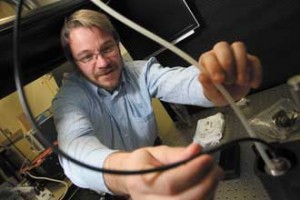
Sci-fi comes to life in Non-Thermal Plasma Processing Lab
By Mark Shainblum
Plasma, as those of you who were paying attention in high school physics may remember, is the fourth distinct state of matter in addition to solids, liquids and gases. Broadly speaking, plasma is somewhat like a gas where some atoms and molecules have been stripped of their electrons, permitting electrical conductivity. Natural plasmas are everywhere, from lightning bolts to the Northern Lights to the surface of the sun itself. In fact, plasma is by far the most common type of matter in the universe.
Despite its overwhelming popularity on the cosmic scale, humans discovered and named plasma less than 150 years ago, so the three classic forms of matter still occupy most of our mindshare. But just because you’re not thinking about plasma, that doesn’t mean it’s not thinking of you: Plasmas are now as domesticated as terriers and tabbies. Every time you power up a plasma-screen TV, computer projector or compact fluorescent lightbulb, for example, that’s plasma going to work. Less obviously perhaps, many high-tech objects surrounding us work only because of modifications made possible by plasma-based manufacturing technologies. These include aircraft engine parts, medical implants and non-stick cookware, to name only a few.
Dr. Sylvain Coulombe gives plasma an even tougher workout. An Associate Professor in the Department of Chemical Engineering since 2001, Coulombe holds the Canada Research Chair in Non-Thermal Plasma Processing. Not surprisingly, he’s also director of McGill’s sprawling Non-Thermal Plasma Processing Laboratory in the Wong Engineering Building, where he spearheads such science-fictiony-sounding projects as the Atmospheric Pressure Glow Discharge torch (APGD-t) and the nanofluid synthesis reactor.
As an engineering physicist, it’s Coulombe’s job to fuse the theoretical with the practical. “Chemistry and physics are about the fundamentals of how molecules interact with one another, and how you use those interactions to produce new substances and products,” he said. “In Chemical Engineering we do fundamental science, but that’s not the ultimate goal. We use what the chemists and physicists develop and move it to a larger scale. We also try to merge different research fields to come up with useful products and devices.”
The APGD-t certainly meets those criteria. Designed for “advanced surface engineering,” it can modify the surface of everything from ceramics to metals to human cells. Plasmas, and in particular the so-called “cold plasmas,” are breaking new ground in the field of plasma medicine, where Dr. Coulombe and his group are pioneers.
“Ten years ago, people were interested in simply sterilizing or enhancing the surface properties of biocompatible surfaces,” Coulombe said. “Now we can trigger delicate natural processes inside cells with plasma. In particular, we now use plasma to assist the process of cell transfection. We create pores in the cell membrane, allowing us to inject foreign molecules into it.”
The APGD-t has generated intense interest in the biotechnology field, and a spin-off company called NexPlasmaGen has been founded by one of Coulombe’s former graduate students to help commercialize the technology, supported by McGill’s Office of Technology Transfer and the Quebec government. However, Coulombe stresses, the technology is so multifunctional that it crosses disciplinary boundaries in all directions.
“The APGD-t has even been modified to play pure, monotonic sounds,” he said with a laugh, adding that he does not see a real application for this.
“While the plasma is going, we create something like an AM radio wave, amplitude modulation,” he explained. “We change the power as a function of time and generate acoustic waves and get very pure sounds. We even tuned a guitar with it, it’s so pure.”
“Science and engineering meet here,” he said. “If you look at my research group, I have a background in engineering and physics myself. We have people from chemistry, and now a post-doctoral researcher from biology. There are people from every discipline here. Everybody has to contribute, because this is a ground for a wide range of applications.”
Star Labs is an occasional feature putting the focus on cutting-edge laboratories and research sites at McGill. Know of a lab that deserves the Star treatment? Drop us a line at mark.shainblum@mcgill.ca.
Links to cool stuff in the Coulombe Lab:
Quicktime movie of the AGPD-t playing music
Images of the APGD-t and some of the results it can achieve:
